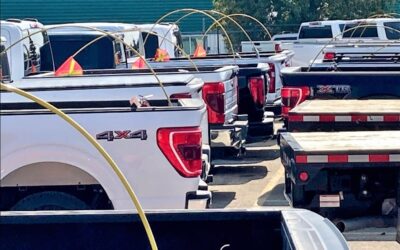100% Fleet Utilization – It Can Be Possible
Having efficient fleet utilization is a key component to running a successful company. Many fleets are only utilized to 50%, or less, of their potential 100% utilization. This utilization gap can be decreased if new tactics are implemented to increase the utilization of a fleet. If this gap is effectively decreased, companies can ultimately become more profitable since fleet costs can be reduced. Controlling fleet inventory, reducing idling fleets, and renting a fleet are some of the solutions to get closer to 100% fleet utilization.
Controlling Fleet Inventory
A good place to start in increasing fleet utilization, is knowing what vehicles compromise your fleet. Knowing what vehicles are in your fleet may seem obvious and a basic aspect of utilization, yet it is more about knowing how to effectively use the right vehicles for the right jobs. Having vehicles with fleet tracking devices is important because fleet managers can gain access to vehicle usage and take corrective actions if necessary. Making sure you have right sized the vehicle for the assignment is also another way to maximize fleet usage. For example, if a vehicle in your fleet is used to deliver goods and each truck that goes out for delivery is only half full, that truck is underutilized. If this is a regular occurrence, swapping vehicles for this work would reduce costs. Another option is to consider downsizing your fleet which would increase usage of remaining vehicles but they may not be fit for purpose. It is important to match vehicles in the fleet with assignments that maximize fleet value.
Reducing Idling Fleets
Being able to track fleet usage is another important factor in getting closer to 100% utilization. When vehicles are used on any given day in operations, making sure those vehicles are being used in the most effective way possible is crucial to increase utilization. Truck drivers run the risk of misuse to the vehicle. This misuse is often done by excessive breaking or idling while driving. Tracking miles travelled, and vehicle usage patterns in terms of work day can help increase utilization rates. As an example, a fleet manager can leverage this information to change or recommend new travel patterns to reduce rush hour trips where mileage will be lower.
Optional Fleet Usage
Another way to increase fleet utilization is to consider the use of other vehicles in a fleet. Optional vehicles may be surplus vehicles or pool cars that are already a part of your fleet. The use of surplus vehicles or pool cars can be very low cost. Many of the vehicles that are surplus are usually in the latter stages of its useful life. It is imperative that when using either of these options in a fleet that the driver, date, and time each vehicle is used, can be tracked in case of misuse to the vehicle. Reimbursement vehicles is another way that may make sense for a fleet to be better utilized. Reimbursement vehicles are vehicles in a fleet that not owned by the company but instead the company will reimburse the driver for variable costs such as gas. This is a great alternative since there are no acquisition costs and maintenance costs fall to the driver, not the company.
Renting a Fleet
In getting closer to 100% fleet utilization, renting is an excellent option. With companies such as Summit Fleet, vehicles can be rented based on certain jobs on a month-to-month basis. This option is especially useful for times of increased usage when more vehicles are needed for a short time span. Another great time to choose rental vehicles to increase utilization is if the timeline of a job is unclear. Renting allows the company to ensure that the vehicle is fit for purpose and is used just for the duration of the assignment. One big concern with fleet ownership, is the vehicle depreciation. When a company chooses to rent some of the vehicles, the concern about depreciation no longer becomes an issue. When renting vehicles from Summit Fleet, all vehicles are rented monthly with a large inventory of vehicle choices and top of the line features including GPS tracking.
Conclusion
In conclusion, utilization rates are much lower than they should be. There are many alternatives that companies can try to implement to increase their utilization rates. Making use of vehicles that are already a part of a fleet is the first step, but other options should also be considered. Fleet utilization is a very important and requires a model that allows flexibility to handle changing and peak demands. Renting all or part of your fleet provides this flexibility and transfers ownership of fleet depreciation and maintenance to the rental company. To increase fleet utilization, it is necessary that companies try some of the suggestions above. If fleets are not utilized to their fullest potential then fleet managers are ultimately losing valuable money that could be spent elsewhere.
Sources
https://trucking.penton.com/wp-content/uploads/Fleet-Owner-Solutions-Guide-2017.pdf
https://www.b-eye-network.com/view/14816
https://www.autorentalnews.com/article/story/2010/01/how-to-improve-utilization-and-still-satisfy-the-customer/page/3.aspx
https://www.government-fleet.com/channel/operations/article/story/2017/05/the-pennsylvania-fleet-leaner-but-no-less-capable.aspx
https://www.transpoco.com/blog/fleet-asset-utilization-rate-5-metrics-you-need-to-control






